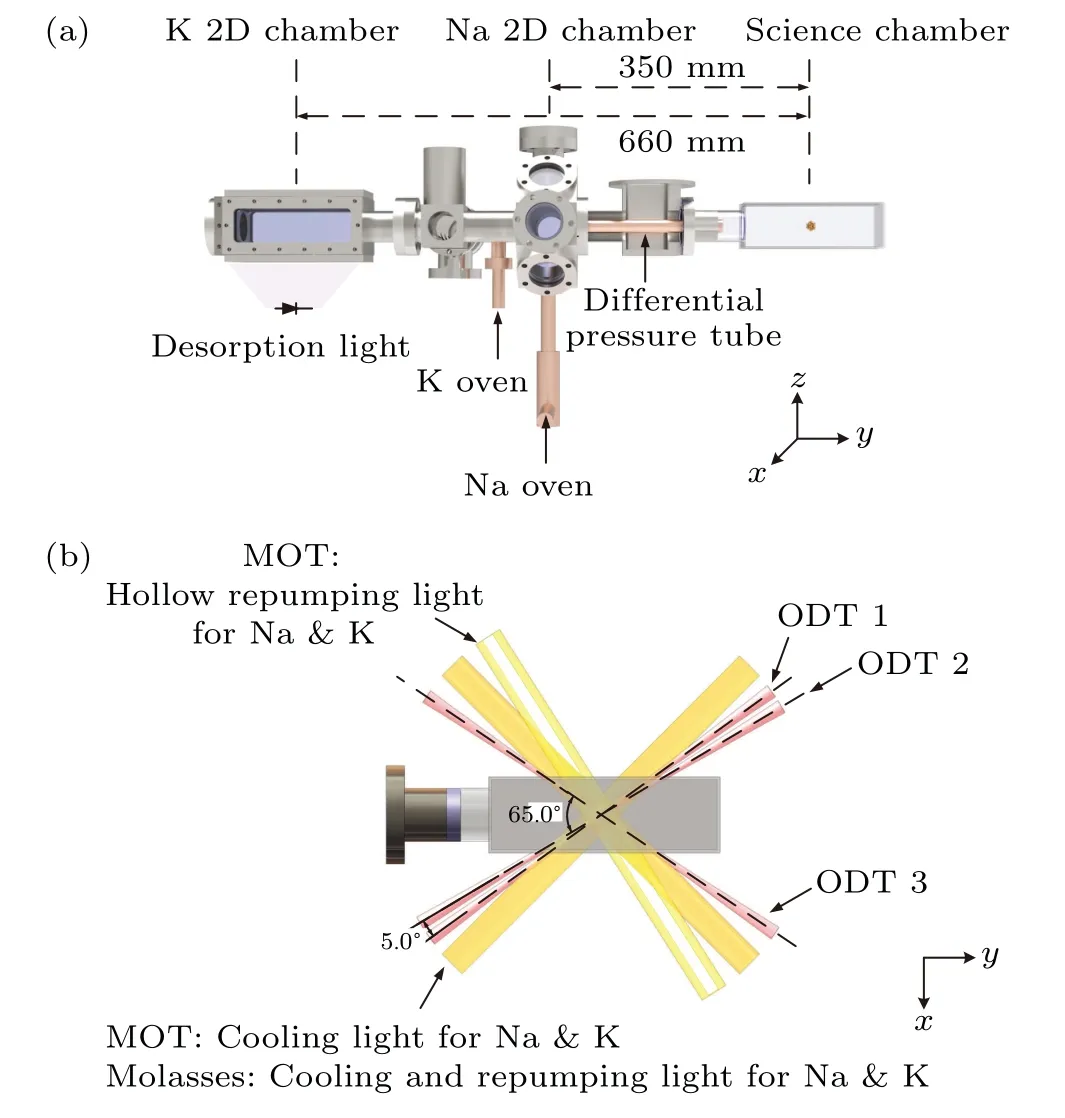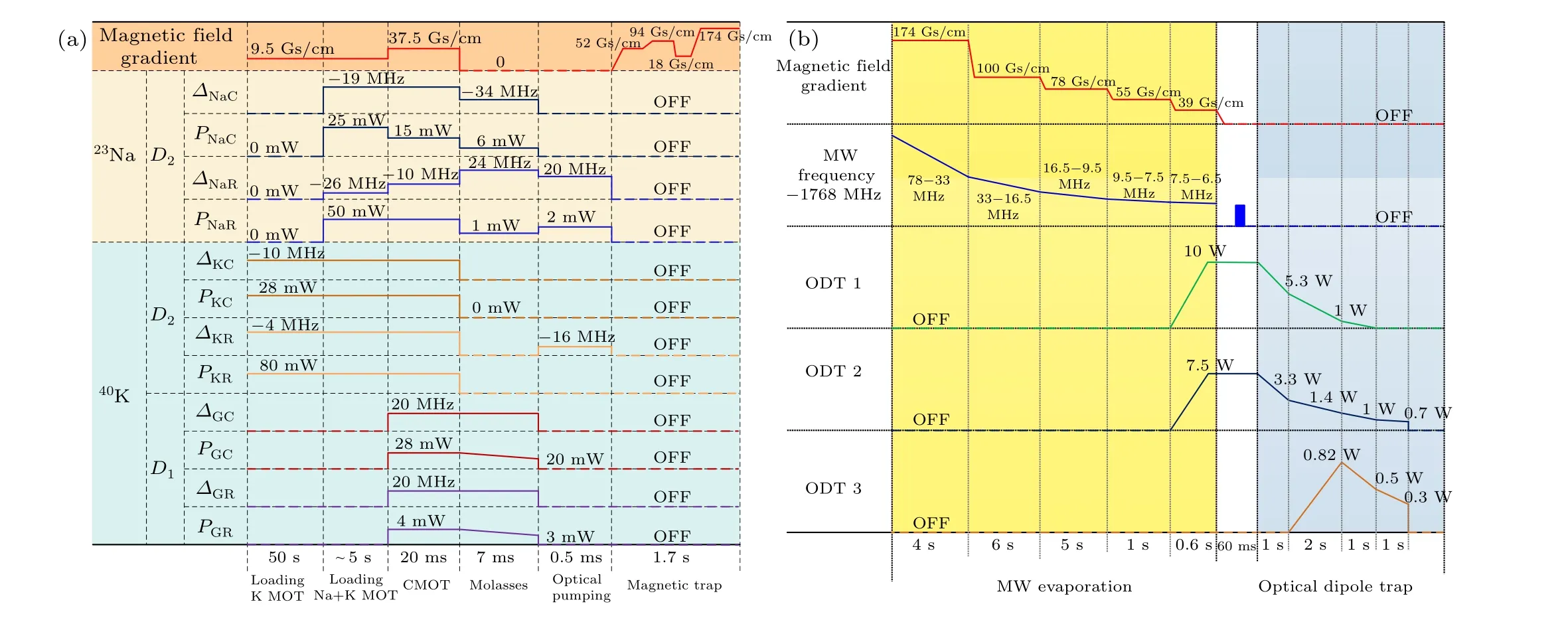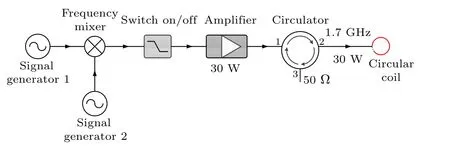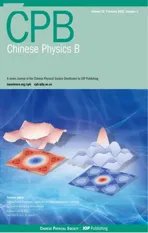Quantum degenerate Bose-Fermi atomic gas mixture of 23Na and 40K
2023-03-13ZiliangLi李子亮ZhengyuGu顾正宇ZhenlianShi师振莲PengjunWang王鹏军andJingZhang张靖
Ziliang Li(李子亮), Zhengyu Gu(顾正宇), Zhenlian Shi(师振莲), Pengjun Wang(王鹏军), and Jing Zhang(张靖)
State Key Laboratory of Quantum Optics and Quantum Optics Devices,Institute of Opto-electronics,Collaborative Innovation Center of Extreme Optics,Shanxi University,Taiyuan 030006,China
Keywords: ultracold gases,degenerate Bose-Fermi mixture
1.Introduction
Quantum degenerate gases mixture composed of different species provides an ideal physical platform for studying strongly correlated many-body physics in a clean and well-controlled environment.[1]The existence of the specific parameter of the interplay between the inter- and intra-interactions provides the rich and various subjects,compared to the single species experiment, such as ultracold chemistry,[2-4]fermionic heteronuclear molecules,[5]precision measurement,[4]dual superfluidity,[6]vortices in superfluids,[7]polaron physics,[8,9]fermion-mediated longrange interactions between bosons,[10,11]and so on.To date, many different kinds of Bose-Fermi gas mixtures have been cooled to quantum degeneracy, including6Li-7Li,[12,13]87Rb-40K,[14]23Na-6Li,[15]87Rb-6Li,[16]3He-4He,[17]173Yb-174Yb,[18]87Sr-84Sr,[19]6Li-174Yb,[20,21]40K-23Na,[22]87Rb-171Yb,[23]41K-6Li,[7]174Yb-6Li,[24]6Li-133Cs,[25]and6Li-84Sr.[26]
The ultracold Bose-Fermi mixture of23Na and40K atoms with rich Feshbach resonances has attracted enormous attention, such as forming the fermionic ground-state23Na40K molecules with a large electric dipole moment of 2.72 Debye and the special property of chemical stability,[27-29]and creating the Bose polarons near quantum criticality in the unitary regime.[30,31]The prospect is exciting, nevertheless cooling the mixture to the nanokelvin regime is more difficult than single atomic species.There are many problems that prevent the effective cooling of the mixture to quantum degeneracy.Firstly, the light-assisted loss in the loading stage of two species magneto-optical trap (MOT) results in a shorter lifetime and less number of the mixture.Secondly,the background triplet scattering length of interspecies between23Na and40K is large with≈-824.7(30)a0[32,33]and induces less efficiently sympathetic cooling in the magnetic trap than other mixtures.[22,34]Thirdly,due to the temperaturedependent three-body loss,23Na and40K atoms in the low field seeking stretched states|2,2〉and|9/2,9/2〉in the magnetic trap were not able to be effectively cooled to quantum degeneracy.Lastly, the spin relaxation of the mixture of40K in|9/2,9/2〉and23Na in|1,-1〉is strong,which makes it impossible to coexist in the magnetic trap.
In this paper,we present a compact vacuum system without the standard Zeeman slower and an optimized cooling route for preparing the quantum degenerate atoms mixture of23Na and40K in an optical dipole trap, and demonstrate that23Na atoms could be an efficient coolant for sympathetic cooling of40K atoms.In order to tackle the above mentioned problems,we use state-of-the-art cooling techniques in the experiment.Dual dark MOTs and timesharing loading of two species are used to reduce the light-induced loss in the MOT loading stage as much as possible.To effectively cool the mixture before loading atoms into the magnetic trap,the gray molasses technology onD1line for40K and onD2line for23Na are used to provide a good start point for the further evaporation cooling.The pre-cooling of the mixture is done by microwave (MW) evaporation of23Na to 12 µK in an optically plugged magnetic trap with40K in|9/2,9/2〉and23Na atoms in|2,2〉.In order to reduce the three-body loss between atoms in this forced evaporation process, the magnetic field gradient is reduced simultaneously to reduce the atoms peak density.At last, both species are transferred into a large volume,far-detuned optical dipole trap(ODT)at the end of MW evaporation and prepared40K in|9/2,9/2〉and23Na atoms in|1,1〉quickly.After an evaporation of 5 s in an optical trap,we prepare a degenerate Fermi gas of40K in|9/2,9/2〉with 1.9×105atoms atT/TF=0.5, and a sample of23Na atoms in|1,1〉with 8×104in BEC and 1.5×105thermal atoms at a temperature of 300 nK.
2.Experiment setup
2.1.Vacuum setup
The vacuum system of the experimental apparatus is shown in Fig.1(a), which has been used to create BEC of23Na.[35-38]The vacuum setup is composed of two parts connected through a differential pumping tube with internal diameter of 6 mm and length of 190 mm.The first part is for a two-dimensional(2D)magneto-optical trap(2D-MOT)which is devoted to the atomic source with a pre-cooling stage with a background pressure of 1×10-7Pa maintained by an ion pump with a pumping speed of 40 L/s.The two species atoms are loaded in the independent vacuum chambers.A stainless steel square chamber for40K and a metallic stainless steel 316 L octagonal cavity for23Na are connected in series.The second part is an ultrahigh vacuum science chamber,which is composed of a quartz glass cell with a background pressure of 9×10-10Pa maintained by an ion pump with a pumping speed of 150 L/s.Here,the23Na and40K are trapped in a two-species dark MOT and then cooled in an optically plugged magnetic trap and an optical dipole trap in sequence.
The Na oven is heated to 200°C for the sodium source and the K oven at 50°C,resulting in the background pressure increasing to 2×10-7Pa in the first vacuum part.To prevent atoms from sticking to the walls and glass windows of the vacuum chamber,all viewports of the Na 2D chamber are heated at~70°C.
The40K atoms in 2D-MOT are collected from the background gas.In order to increase the background pressure and prevent atoms from sticking to the glass windows, the entire K 2D chamber is heated at~50°C, and at the same time,we use ten light-emitting diodes(LEDs)to emit light at nearly 405 nm(NCSU233B,Nichia Corp.) for light-induced atomic desorption on the glass windows.The LEDs are mounted on a heat sink around the K 2D chamber and each LED emits about 1.4 W of light power.This light-induced desorption technique has been successfully used in the experiments of quantum gas for87Rb,[39,40]133Cs,[41]40K,[42]7Li,[43]and23Na.[44,45]

Fig.1.(a) Front view of the compact vacuum system for the production Bose-Fermi quantum degenerate,consisting of two major parts: 2DMOT chamber of23Na and40K and a glass science chamber.(b)Top view of the glass science chamber with the optical setup,which collects atoms in the 3D-MOT by six overlapped cooling light beams and a hollow repumping beam and is used for the gray molasses by the light beams with cooling and repuming frequency.The far-off resonant 1064-nm crossed optical dipole trap is consisted of three laser beams(ODT 1,ODT 2,and ODT 3)in the x-y plane.
2.2.Laser setup system
In this section, we briefly describe the laser systems designed for potassium atoms onD2line andD1line.The sodium laser system has been described in our previous works.[35-37]The laser frequencies for double dark threedimensional(3D)MOT of Na and K atoms and the gray molasses cooling of K atoms onD1line are shown in Fig.3(a).
A layout of the40K laser setup is presented in Fig.2.In order to overlap perfectly the laser beams onD1line for gray molasses cooling withD2line for MOT trapping,the injection locking laser frequency technique is used.Two master lasers are used in experiment,one operating atλ=766.7 nm,which is locked at theD2transition of39K 42S1/2|F=1〉→42P3/2|F''=0-2〉crossover signal via absorption spectroscopy,the other operating atλ=770 nm, and is locked at theD1line transition of39K,42S1/2|F=1〉→42P1/2|F'=2〉.Thanks to the ground state hyperfine splitting of 1285.8 MHz of40K,the required repumping and cooling frequencies could be obtained by means of acousto-optic modulators (AOMs).The AOMs are used as the frequencies tuners and fast switchers on the nanosecond timescale, which could meet the requirement on the fast frequency handoff of the slaver lasers fromD2line toD1line.
Using the injection locking laser frequency technique,the slave laser frequency follows the chosen injection laser beam onD1orD2line from two master lasers using a polarization beam splitter (PBS).Then the output laser beam from slave cooling laser is amplified by a tapered amplifier (TA).And the repumping beam have a similar setup.The amplified laser beams are delivered to 2D and 3D dark MOTs.The laser beams for 3D dark MOT include six cooling beams and one repumping beam by seven polarization maintaining optical fibers and expanded 1/e2diameter to 25 mm,as shown in Fig.1(b).

Fig.2.The optical setup of the D1 and D2 line laser systems for 40K.

Fig.3.(a)Energy level diagram for 23Na and 40K.The ΔNaC and ΔNaR are the detunings of the cooling and dark repump laser shown in the D2 line of 23Na.The ΔKC and ΔKR are the detuning of the cooling and dark repump laser from the atom transition in the D2 line(766.7 nm).The ΔGC and ΔGR are the GM cooling and repump laser detuning from the atom transition in the D1 line(770 nm).(b)The ground-state hyperfine structure of 23Na and 40K in an external magnetic field.The spin states prepared in the experiment are highlighted through color.The unit 1 Gs=10-4 T.
3.Dual species dark MOT and gray molasses
The40K atoms are collected from a 2D MOT.Two pairs of rectangular coils around the vacuum chamber generate a magnetic field gradient of about 9 Gs/cm for 2D MOT.The cooling beams with red detuned frequency 10 MHz from the|F=9/2〉→|F=11/2〉transition and repumping beam with red detuned frequency 4 MHz from the|F=7/2〉→|F=9/2〉transition are used for40K.The40K atoms are pushed to the science chamber by a push beam with blue detuning of 5 MHz along theydirection about 660 mm from 2D MOT to 3D MOT.The 2D MOT for23Na has been described in our previous works.[35-37]The23Na atoms are pushed to the science chamber by a push beam with a distance of about 350 mm from 2D MOT to 3D MOT.
In the science chamber, the23Na and40K atoms are collected by the dark MOT of two species.For the operation of dark-spot MOT,six cooling beams combining23Na with40K light counter-propagate in pairs and are orthogonal to each other in three directions.A single repumping beam with a black spot of 10-mm diameter at the beam center is applied,
where two species’ repumping laser beams are overlapped through dichroic mirrors,as shown in Fig.1(b).This method could create a dark regime in the center of MOT, where the atoms of23Na and40K stay at the dark ground states|F=1〉and|F=7/2〉.Therefore, the light-assisted loss in the two species’ MOT is reduced significantly.The quadrupole magnetic field with a gradient of 9.5 Gs/cm along thezdirection,generated by a pair of coils in the anti-Helmholtz configuration,is used for loading atoms in the 3D MOT.
In order to overcome the light-assisted loss in two species MOT,[46]there are many techniques developed for the mixture of23Na and40K atoms, such as the dark MOT of two species, two-stage MOT loading approach,[47]and mismatch of the atomic cloud position of two species realized by slight displacement of the MOT laser beams.[48]In our experiment,we could not observe any40K atoms after two species loading in the dual-species dark MOT of 30 s at the same time,which maybe due to the enhanced loss from the same loading road from 2D MOT to 3D MOT.Benefiting from the faster loading rate of Na than K,we use a timesharing loading technique for the two-species atoms,firstly only loading K for 50 s and then loading Na in the last 4.5 s.The time sequence is shown in Fig.4(a).

Fig.4.Experimental sequence for the loading processes(a)and the evaporation(b).
Generally,the dark MOT could capture more dense atoms than bright MOT,and then is followed directly with the optical molasses in sequence.[49,50]In our experiment, we optimized the following cooling steps after the dark MOT loading stage.A quick transfer process to bright MOT of23Na is accomplished in 10 ms, and then a compressed MOT (CMOT) step is followed during 20 ms by increasing the magnetic field gradient to 37.5 Gs/cm and changing the power and detuning of the cooling and repumping light.For40K atoms,a hybridD1-D2technique is implemented.[51]The slave repumping laser is switched to be injected into TA with the slave cooling laser together, which corresponds to the bright MOT configuration for40K.The frequencies and powers of the lasers are shown in Fig.4(a).
An optical molasses step follows the CMOT step.The six beams are switched to carry the23Na and40K cooling and repumping light simultaneously and the single repumping beam with a black spot is switched off.The magnetic field has been turned off 1 ms in advance.The23Na atoms are cooled to 56µK in 7 ms by the gray molasses ofD2line.This technology has been used in Refs.[35,52].The40K atoms are cooled to about 20 µK during the same time by the gray molasses ofD1line,[53]in which both frequencies of cooling and repumping laser,are blue detuning(ΔGC=ΔGR=20 MHz)that form Λ-type three-level system, as shown in Fig.3(a).The cooling/repumping intensity ratio is optimized at about 7:1 by measuring the loading rate in the optically plugged magnetic trap.The laser power and duration time are given in Fig.4(a).
4.Precooling in an optically plugged magnetic quadrupole trap
To effectively load the two species mixture into the magnetic trap for further cooling, an optical pumping stage of 0.5 ms is used to prepare the atoms in the double spinpolarized states.We prepare the mixture in the hyperfine ground state|2,2〉for sodium and|9/2,9/2〉for potassium by using a circularly polarized light on the|F=2〉→|F''=2〉and|F=9/2〉→|F''=9/2〉transition respectively.At the same time,about 1-Gs homogeneous magnetic field is applied along theydirection.
After the spin state preparation,the magnetic field gradient of the quadrupole magnetic trap is ramped from 0 Gs/cm up to 52 Gs/cm in 10 ms, then up to 94 Gs/cm for 500 ms and holds on 20 ms for thermalization.Then it is reduced to 18 Gs/cm in 200 ms and holds this value on 500 ms for spinpurification to remove the23Na atoms in|2,1〉and|2,0〉.Because the spin exchange collision between two states induces the atoms heating strongly.[47]
In this process, the magnetic field gradient can only hold the sodium atoms in|2,2〉state,the atoms at other hyperfine states leave the trap in the direction of the gravity,which prevent the spin collision relaxation and heating process in the atoms sample.In this step, the potassium atoms can not be influenced because of the larger magnetic moment.
The trap gradient is then again increased to 174 Gs/cm in 500 ms to compress the atoms sample for effective elastic collision in the following MW forced evaporation.At the end of this stage,a plug laser beam operating on 532 nm of 18 W with 1/e2radius of 35µm provides a potential barrier of about 615 µK in the center of the magnetic quadrupole trap to prevent the Majorana losses at the zero magnetic field regime.At this time, the optically plugged magnetic quadrupole trap is created.
After a thermalization of 100 ms, the mixture is cooled with 16.6 s by MW forced evaporation23Na in the optically plugged magnetic trap, where the transition of23Na|2,2〉→|1,1〉is used for evaporation.Thermal23Na atoms in|2,2〉state are removed from the trap by coupling to the high field seeking state|1,1〉,while40K atoms are sympathetically cooled by elastic collisions with23Na atoms.
Figure 5 shows the MW field scheme for evaporation of Na transition from|2,2〉state to the untrapped hyperfine state|1,1〉.Two signal generators are used to create the MW field between 1.77 GHz-1.85 GHz by mixing a fixed MW signal of 1.768 GHz(from N5183B,Keysight Corp.) with a tunable RF signal (from 33250A, Keysight Corp.).A mixer (ZX05-U432H-S-4+, Mini-Circuits Corp.) is used for the frequency up-converter to generate the MW field for evaporation.The MW signal passes through a broadband switcher (F9114A,General Microwave Corp.), then is amplified to a maximum output power of 30 W by an amplifier (MPA-1600-2000-30,Micotop Corp.),and then sent to a home-build single-loop antenna made of copper bar.In order to protect the amplifier, a circulator is connected in series with the antenna.
In experiment, we also tried the RF evaporative cooling in optically plugged magnetic quadrupole trap for comparison, but found stronger loss which is mainly attributed to the strong inelastic collision of|9/2,9/2〉for potassium and|2,1〉hyperfine ground state for sodium.
How to obtain high atoms density is a challenge in evaporation by balancing enough elastic collision for cooling with the three-body loss of the mixture of Na-K.The elastic collision rate of Na-Na and Na-K for the thermalization process in evaporation is dependent on the atoms density,and the threebody loss rate is also proportional to the density of the mixturen(r,t)Naandn(r,t)K.The three-body collision can be characterized by a loss rate coefficientβNaK, which depends on the microscopic behavior of the collision process[54,55]
By optimizing the evaporation efficiency of the atoms mixture,we design five magnetic gradient decompress steps from 175 Gs/cm to 39 Gs/cm in the entire cooling process to reduce three-body loss.The time sequence is shown in Fig.4(b).At this moment,we have prepared an atomical sample of40K atoms at|9/2,9/2〉state of 4.5×105and23Na atoms at|2,2〉state of 2.5×107at 12µK.The three-body loss evidently increases below 10 µK and prevents the mixture from further cooling to the nK regime in the magnetic trap.The good solution is to further cool the mixture to degenerate in40K|9/2,9/2〉and23Na|1,1〉state in an optical trap.

Fig.5.Sketch of the MW setup used for the evaporation in the magnetic trap and state preparation.

Fig.6.The lifetime of the 40K atoms with 23Na atom in|2,2〉state(blue triangle)and|1,1〉state(red dot)in the optical dipole trap.The solid lines show the numerical fits to the experimental data,which give the lifetime of 400 ms for the mixture of 23Na |2,2〉+40K |9/2,9/2〉 and 8.7 s for the mixture of 23Na|1,1〉+40K|9/2,9/2〉.The inset shows the enlarged evolution of the 40K atoms for the first case.
5.Degenerate Bose-Fermi gases in an optical trap
For cooling to quantum degenerate regime, the atomic sample is transferred into a far detuning,large volume crossed optical dipole trap (λ=1064 nm) consisting of two beams with small intersection angle in thex-yhorizontal plane, as depicted in Fig.1(b).Two beams(ODT1 and ODT 2)crossed with the angle 5°have the focus waist of 100µm and 90µm and ramp up to maximum power of 9 W in 100 ms,which improves the loading efficiency by enlarging the trapping volume to reduce the strong three-body losses.Meanwhile,the green laser is switched off,and the magnetic field gradient is ramped down to 0 Gs in 30 ms.The experimental sequence shows the optimized sympathetic cooling,as shown in Fig.4(b).
After the transfer step, there are 2.2×10540K atoms at 8 µK, and the transfer efficiency from the quadrupole magnetic trap is about 65%.We compare the 1/e lifetimes of the mixture at the different spin states in the large-volume crossed optical trap depicted in Fig.6.Due to the significant threebody loss, the lifetime is just 0.4 s of40K atom in the dipole trap while23Na atoms are in the|2,2〉state.After the atoms are transferred into the optical trap, a rapid spin state transfer process is performed to prepare the sodium atoms in|1,1〉via Landau-Zener sweep by an MW driven transition during 10 ms at a guiding field of 1 Gs, and remove the remaining atoms at|2,2〉state via a resonance light.For the mixture of23Na|1,1〉+40K|9/2,9/2〉,the lifetime can be significantly increased to about 8.7 s for40K.
The first step of forced evaporation of the mixture in the optical trap is to reduce the intensity of the laser beams(ODT 1 and ODT 2).Then in order to increase the collision rate,the other beam (ODT 3) perpendicular to ODT 2 with a waist of 63 µm is focused on the sample and ramped to the power of 0.82 W at the second step evaporation.Then the mixture is further evaporated accompanying a transfer procedure from the large-volume crossed optical trap to a highly confining potential formed by ODT 2 and ODT 3.At the end of the evaporation,a quantum degenerate Bose-Fermi mixture gas is created.Figure 7 gives the absorption images of sodium [panels (a),(c), (e)] and potassium [panels (b), (d), (f)] for the different atomic number ratio by changing the23Na atom loading time in the MOT stage.

Fig.7.Time of flight absorption images of23Na and40K atoms of degenerate Bose-Fermi mixtures.It takes 10 ms for 23Na and 11 ms for 40K of time of flight absorption images.Panels(a)and(b), (c)and(d), and(e)and(f)are pairs of images of 23Na and 40K corresponding to the different ratios of two species’atom numbers.The one-dimensional integrated optical density profiles are plotted at the bottom of the TOF pictures.Atom numbers are(a)3.41×105,(b)0.812×105,(c)2.3×105,(d)1.9×105,(e)1.63×105,and(f)3.17×105.Each image size is 1.6 mm×1.6 mm.
We can produce 1.9×10540K atoms with the trapping frequencies (wx,wy,wz) = 2π×(98,153,182) Hz, and 2.3×105of23Na atoms with 8×104condensed atoms.The temperature of40K atoms is about 0.5TF, whereTFis the Fermi temperatureTF= ¯h¯w(6N)1/3/KB, ¯w=(wxwywz)1/3is the mean trap frequency, ¯his Planck’s constant andKBis the Boltzmann constant.We determine the temperature by Gaussian fits to the wings of the23Na thermal cloud fraction (red lines in Figs.7(a),7(c),and 7(e)).If we only load23Na atoms with 5 s during the MOT loading stage, we could produce a pure Bose-Einstein condensate with 7×10523Na atoms using the same cooling route.
Figure 8 shows the atom number in the mixture at the end of evaporation as a function of the varied loading time for23Na atoms,where the40K atoms are loaded with a fixed time of 50 s.We may create a mixture with a variable ratio of two species atoms by adjusting the loading time of23Na atoms,and use it to explore the physics of Bose or Fermi polarons.When23Na atoms are loaded with 4 s, the two species are equal in quantity about 2×105and have the same temperature of 0.34 µK, which is a good start point for creating ultracold heteronuclear dipolar molecules.

Fig.8.Atom number of 23Na (blue triangle)and 40K(red circle) in the ODT at the end of evaporation as a function of the 23Na MOT loading time.The loading time of potassium atoms is fixed at 50 s.
6.Conclusion
In conclusion, we have described a compact experimental setup and an optimized route in detail to produce a quantum degenerate mixture of Bose gas23Na and Fermi gas40K.We employ different technologies to improve the atomic numbers of the degenerate mixture including dual dark MOT,D2line gray molasses of23Na atoms andD1line gray molasses of40K atoms,the microwave evaporation in the optically plugged magnetic trap and transferring to a large volume optical dipole trap.We measure the lifetimes of the mixture in different hyperfine states and present the efficiently sympathetic evaporation cooling between Na and K atoms in a magnetic trap and optical trap.A degenerate Bose-Fermi mixture atT/TF=0.5 with40K atom number of 1.9×105and23Na 2.3×105is produced.We also could obtain a mixture of tunable atom number ratio at the nK regime by adjusting the23Na MOT loading time.
Acknowledgments
Project supported by the Innovation Program for Quantum Science and Technology (Grant No.2021ZD0302003),the National Key Research and Development Program of China (Grant Nos.2022YFA1404101, 2018YFA0307601,and 2021YFA1401700), the National Natural Science Foundation of China(Grant Nos.12034011,92065108,11974224,12022406, and 12004229), and the Fund for Shanxi 1331 Project Key Subjects Construction.
猜你喜欢
杂志排行
Chinese Physics B的其它文章
- Analysis of cut vertex in the control of complex networks
- Atlas of dynamic spectra of fast radio burst FRB 20201124A
- Investigating the characteristic delay time in the leader-follower behavior in children single-file movement
- Micro-mechanism study of the effect of Cd-free buffer layers ZnXO(X =Mg/Sn)on the performance of flexible Cu2ZnSn(S,Se)4 solar cell
- Thermally enhanced photoluminescence and temperature sensing properties of Sc2W3O12:Eu3+phosphors
- Heterogeneous hydration patterns of G-quadruplex DNA
